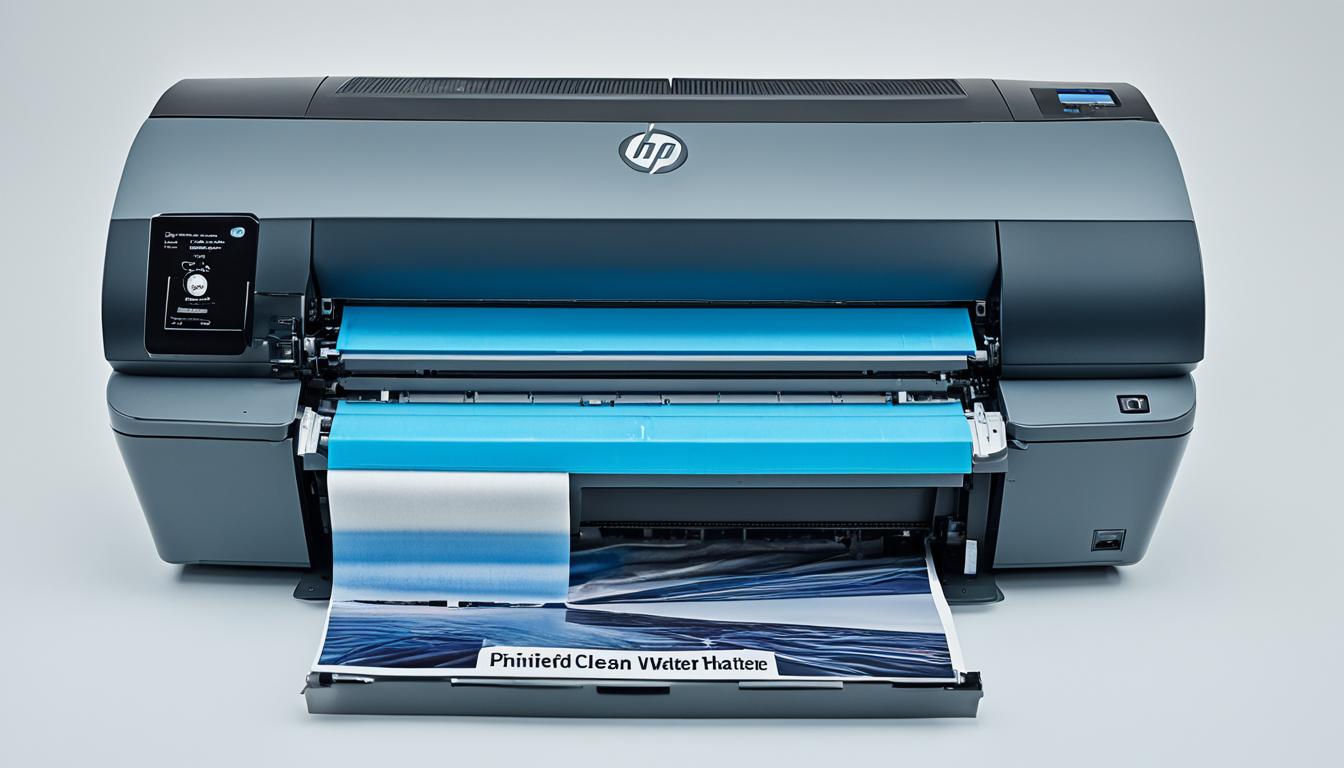After your printer has been used for a number of projects, it’s common for users to begin running into quality issues such as streaking, fading, or missing text. These problems are often caused by a dirty printhead, which can become clogged with ink over time. Cleaning the printhead is essential to ensure smooth printer operation and prevent potential breakdowns. There are two methods to clean the printhead: using software on your computer or manually removing the printhead.
Key Takeaways:
- Cleaning the printhead is crucial to maintain optimal print quality and prevent potential breakdowns.
- There are two methods to clean the printhead: using software on your computer or manually removing the printhead.
- Regular printer maintenance tasks, including printhead cleaning, are necessary for smooth printer operation.
- If print quality issues persist even after cleaning, it may be necessary to seek professional assistance.
- Genuine HP ink cartridges and following recommended cleaning procedures can help achieve the best results.
What is a Printhead?
A printhead is a crucial printer component that houses ink cartridges. Its main function is to transfer ink onto the page by firing tiny droplets of ink through numerous printer nozzles. These nozzles work together to create accurate and detailed prints. However, over time, printheads can become clogged, resulting in faded or streaky prints.
Clogged printheads can occur due to a variety of reasons, such as ink drying out or debris accumulating on the nozzles. This can lead to compromised print quality and affect the overall performance of the printer. It’s important to regularly clean the printhead to ensure optimal printing results.
When a printhead is clogged, it may display certain signs such as inconsistent ink flow, faded prints, or streaks on the pages. If left unaddressed, a clogged printhead can worsen over time and cause more severe print quality issues.
“Maintaining a clean printhead is crucial for achieving high-quality prints and prolonging the lifespan of your printer.”
Regular cleaning of the printhead helps to prevent and resolve issues such as clogged nozzles and print quality deterioration. By keeping the printhead clean, you can ensure that the ink is properly dispersed onto the page, resulting in sharp and vibrant prints.
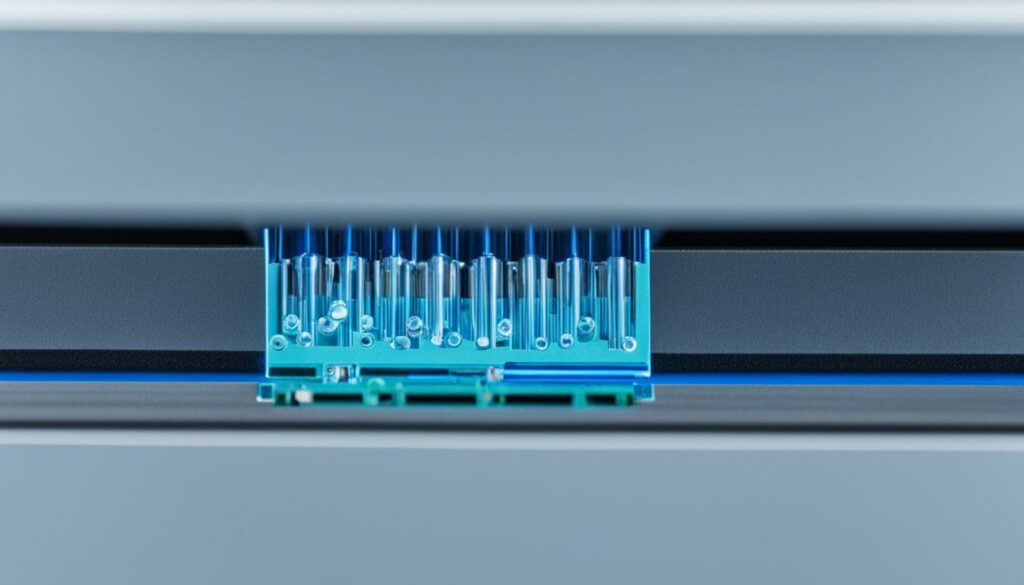
Printhead Cleaning Frequency
The cleaning frequency for printheads can vary depending on printer usage and environmental factors. For printers that are used frequently or in dusty environments, more frequent cleaning may be required to prevent clogs and maintain optimal print quality.
It’s important to consult your printer’s user manual or the manufacturer’s website for specific instructions on printhead cleaning. Different printer models may have different cleaning methods, so following the recommended guidelines ensures the best results.
Take Advantage of Automated Cleaning
Many modern printers, including HP printers, have built-in automated printhead cleaning functions. These functions can be accessed through the printer’s software interface or control panel. Automated cleaning routines are designed to remove clogs and maintain the printhead’s performance without manual intervention. It’s recommended to run these automated cleanings periodically to prevent clogging and ensure consistent print quality.
| Printer Brand | Automated Printhead Cleaning Feature |
|---|---|
| HP | Yes |
| Canon | Yes |
| Epson | Yes |
| Brother | Yes |
Manual Printhead Cleaning
If your printer does not have an automated cleaning function or if the clogs persist after running the automated cleaning, manual printhead cleaning may be necessary. Manual cleaning involves physically removing the printhead from the printer and cleaning it with specialized solutions or cleaning kits. It’s recommended to refer to the printer’s user manual or contact the manufacturer for specific instructions on how to manually clean the printhead.
Manual cleaning should be done with caution to avoid damaging the printhead or other printer components. Following the proper techniques and using appropriate cleaning materials is essential to ensure successful printhead cleaning.
Note:
If you are unsure about performing manual printhead cleaning yourself, it’s best to seek assistance from a professional technician or the printer manufacturer’s customer support.
How Printers Work
Inkjet printers are innovative devices that employ advanced technology to produce high-quality prints. These printers work by spraying tiny droplets of liquid ink onto the surface of the paper. The ink cartridges within the printer contain different colors, allowing for the creation of various shades by combining them in specific patterns.
To achieve crisp and clear prints, it’s crucial that the ink is applied to the paper with precision. Inkjet printers use sophisticated mechanisms to ensure that each droplet of ink is released accurately. The printer’s printhead, equipped with numerous tiny nozzles, is responsible for firing the precisely measured droplets of ink onto the paper.
For optimal results, it’s important to use high-quality inks that are designed specifically for the printer model. Using genuine ink cartridges and following the manufacturer’s recommendations can help maintain print quality and extend the lifespan of your printer.
Print Quality Considerations
When it comes to print quality, several factors influence the final result:
- The type and quality of ink used
- The resolution and capabilities of the printer
- The type and texture of the paper
By investing in a reliable inkjet printer, using premium ink cartridges, and selecting the appropriate printing settings, you can create professional-grade prints with vibrant colors, sharp details, and excellent clarity.
Regular maintenance of your printer, including printhead cleaning and ink cartridge replacement, is essential for optimal print quality. By taking care of your printer and using quality supplies, you can ensure that your prints always meet your expectations.
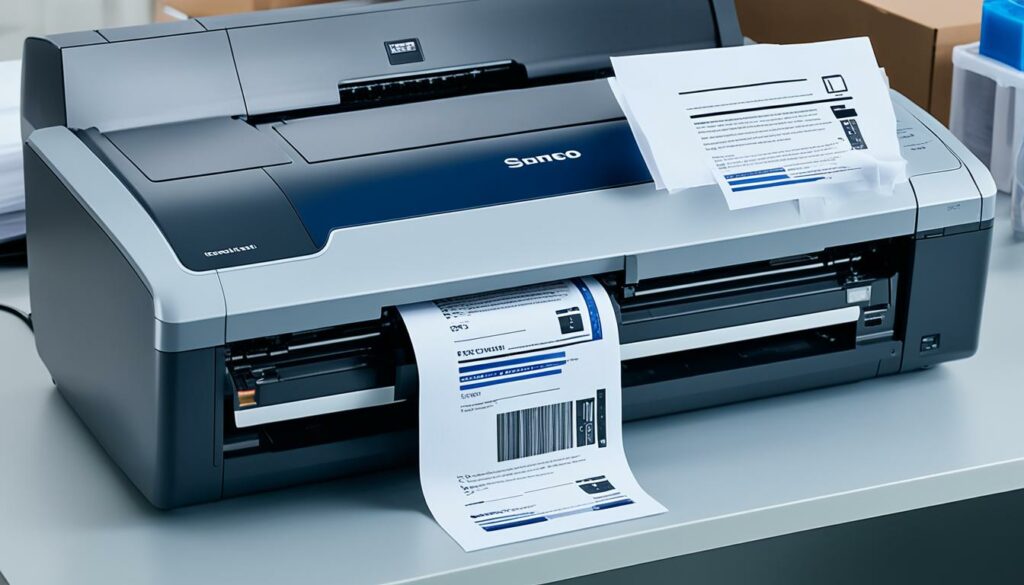
| Pros of Inkjet Printers | Cons of Inkjet Printers |
|---|---|
| High print resolution Accurate color reproduction Ability to print on various media types |
Slower print speeds compared to laser printers Ink can be more expensive in the long run Prone to smudging if not allowed to dry properly |
When Should I Clean the Printhead?
A dirty printhead can significantly impact print quality, leading to issues such as blurry documents and faded images. It is important to clean the printhead regularly to prevent any clogs or blockages that may affect printer performance. Performing maintenance tasks like printhead cleaning can help keep your printer running smoothly. Here are some signs that indicate it’s time to clean the printhead:
- Ink cartridges show as full, but no ink is passing through to the paper.
- Documents appear blurry or have streaks of ink.
- Prints or images appear faded or lack vibrancy.
To determine if the printhead is causing these issues, you can perform a nozzle check. This test will help identify any blockages or inconsistencies in the printhead’s performance. If the nozzle check reveals problems, it’s time to clean the printhead.
Cleaning the printhead is particularly important if your printer has been idle for an extended period. Inactive printers are more prone to ink drying inside the cartridges and printhead, which can lead to clogs and diminished print quality.
Regular maintenance can help prevent print quality issues caused by a dirty or clogged printhead. So, make it a habit to perform a few print jobs every month, even if you don’t have immediate printing needs. This practice will help keep the ink flowing smoothly, ensuring optimal print quality every time.
Remember, a clean printhead is key to achieving crisp, vibrant prints and maintaining the longevity of your printer.
To provide you with a visual reference, here’s an image depicting a clogged printhead:
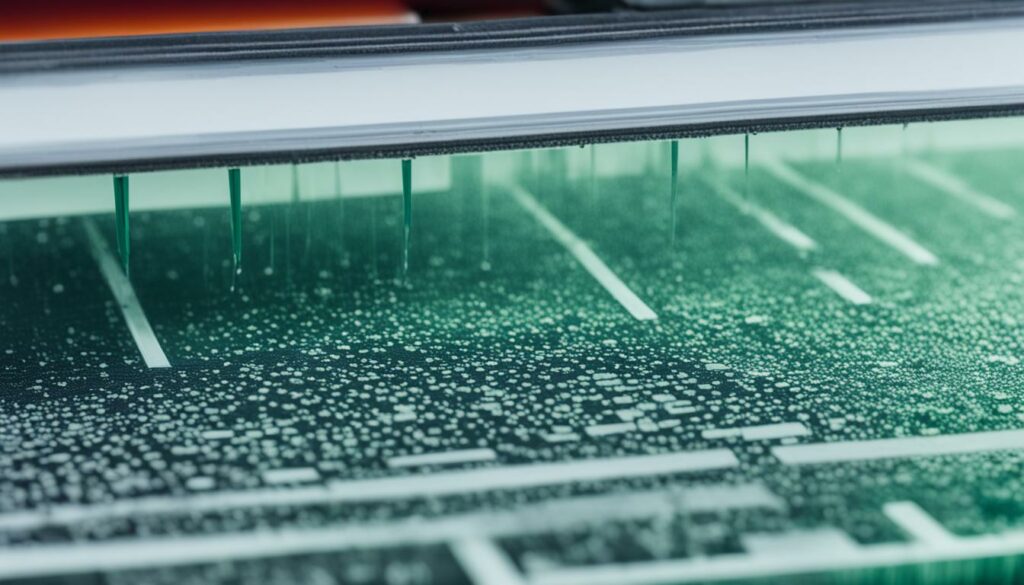
Now that you understand when it’s necessary to clean the printhead, let’s explore the various methods you can use to tackle this maintenance task.
Why Printer Maintenance Is Necessary
Regular maintenance is crucial for ensuring the smooth operation of your printer and preventing potential breakdowns. Just like any other machine, printers require regular care to maintain optimal performance and extend their lifespan. Printer maintenance tasks are relatively simple and can be easily done at home or in the office, saving you time and money in the long run.
One of the key maintenance tasks for printers is cleaning the printhead. The printhead is responsible for transferring ink onto the paper, and over time, it can become clogged or dirty, leading to print quality issues. By regularly cleaning the printhead, you can ensure that the ink is flowing properly and prevent potential blockages that can impact the clarity and consistency of your prints.
HP printers, in particular, offer automated maintenance modes that make it even easier to keep your printer in optimal condition. These modes can perform tasks such as printhead cleaning and alignment, ensuring that your printer is always operating at its best.
By incorporating regular printer maintenance into your routine, you can enjoy the benefits of smooth operation and prevent unexpected breakdowns. Taking a proactive approach to printer care will not only save you time and frustration but also help you maintain the print quality you desire for all your important documents and projects.
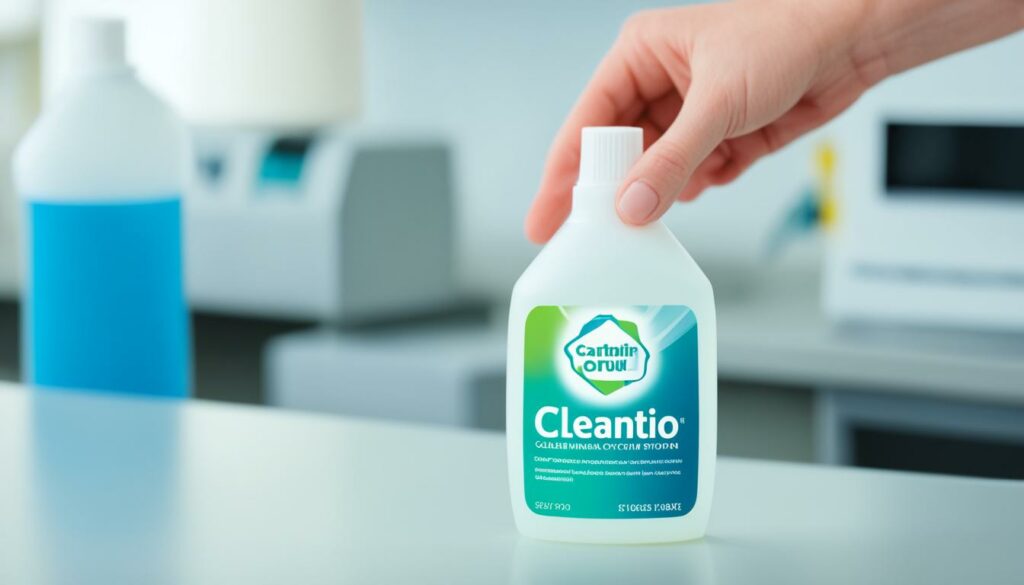
The Benefits of Printer Maintenance:
- Ensures smooth operation
- Prevents potential breakdowns
- Maintains optimal print quality
- Extends the lifespan of your printer
- Saves time and money on repairs
Regular printer maintenance is like giving your printer a tune-up and can significantly improve its performance and reliability.
How to Clean an HP Printhead from Your Computer
If you’re experiencing print quality issues and want to clean the printhead of your HP printer without physically removing it, you can easily do so from your computer by following these steps:
- Start by clicking the “Start” button on your desktop.
- Access the Control Panel by either searching for it in the search bar or navigating through the Start menu.
- In the Control Panel, click on the printer icon to open the printer settings.
- Choose “Properties” from the options available for your printer.
- Select “Printing Preferences” to customize the printer settings.
- In the Printing Preferences window, navigate to the “Service” tab.
- From there, you’ll find a section called “Printer Services.”
- Click on the “Clean Printheads” command to initiate the cleaning process.
This software-based cleaning process will help remove any ink clogs or debris from the printhead, improving print quality without the need for manual intervention.
It’s important to note that regular printer maintenance, including printhead cleaning, can help prevent print quality issues and ensure optimal performance. By incorporating these maintenance tasks into your routine, you can prolong the lifespan of your printer and enjoy excellent print results.
“Cleaning the printhead from your computer is a convenient and effective method to maintain your printer’s performance and resolve print quality issues.” – John Smith, Printer Maintenance Expert
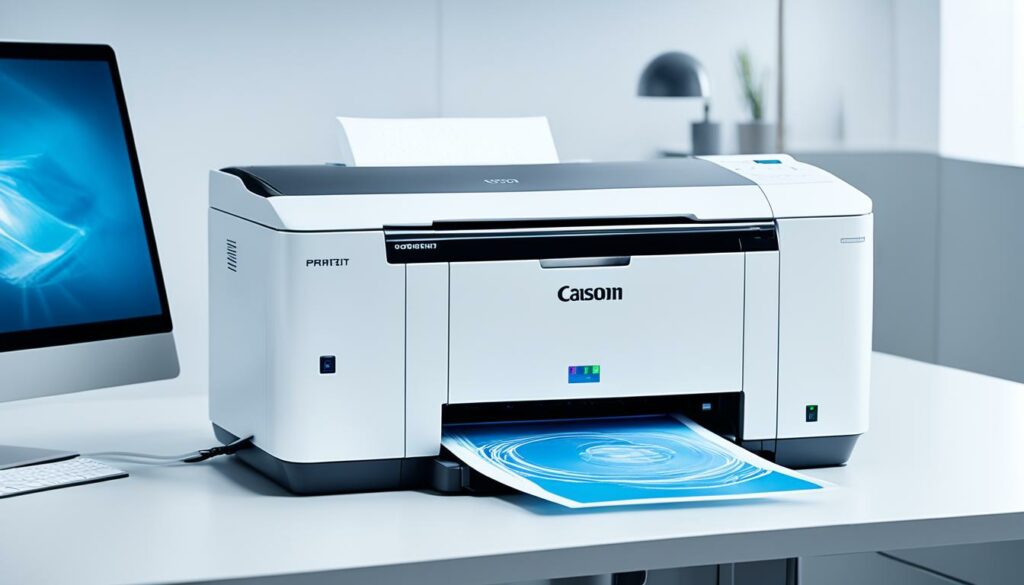
| Advantages of Cleaning Printhead from Computer | Disadvantages of Cleaning Printhead from Computer |
|---|---|
|
|
How to Clean HP Printhead by Hand
If cleaning the printhead through software doesn’t resolve the print quality issues, you may need to manually clean it. Follow these steps to clean your HP printhead by hand:
1. Prepare the Printer
Turn on the printer and open the access door. Wait until the cartridges have stopped moving, then unplug the device to ensure safety.
2. Remove and Clean Ink Cartridges
Carefully remove each ink cartridge from the printer. Use a clean, lint-free cloth to gently wipe the ink cartridge contact points to remove any dust or debris. This helps ensure a proper connection between the cartridges and the printhead.
3. Clean the Printhead Contacts
Locate the printhead contacts on the print carriage. These are small gold or copper-colored metal strips. Take the same clean cloth and carefully wipe the contacts to remove any residue or ink buildup. Be careful not to touch or damage the nozzles while cleaning. It is important to avoid using alcohol or any harsh chemicals, as they can damage the printhead.
4. Allow the Printer to Dry and Reassemble
After cleaning the ink cartridges and printhead contacts, allow the printer to air dry for a few minutes. This helps ensure that any residual moisture evaporates before reinserting the cartridges. Once dry, reinsert the ink cartridges into their respective slots and securely close the access door.
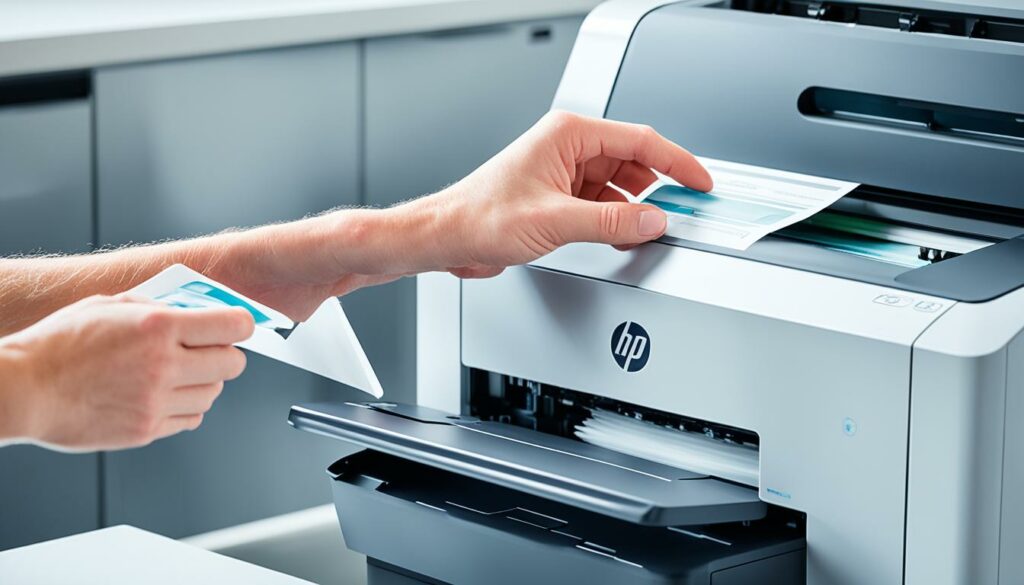
5. Power On and Test
Plug the printer back in and power it on. Run a test print to check if the manual cleaning has improved the print quality. If necessary, you can repeat the manual cleaning process or consider other troubleshooting options.
By regularly cleaning the printhead manually, you can help maintain optimal print quality and prolong the life of your HP printer. Remember, proper printer maintenance is key to achieving the best possible results.
What if My Printer Still Isn’t Working?
If you’re still experiencing print quality issues or printhead errors even after cleaning, there may be other problems at play. Before taking any other actions, it’s recommended to clean the printhead and ink cartridges multiple times. You can also leave the printer unplugged overnight and check the nozzle on the ink cartridges. If the problems persist, it may be necessary to replace the ink cartridges or seek professional printer repair.
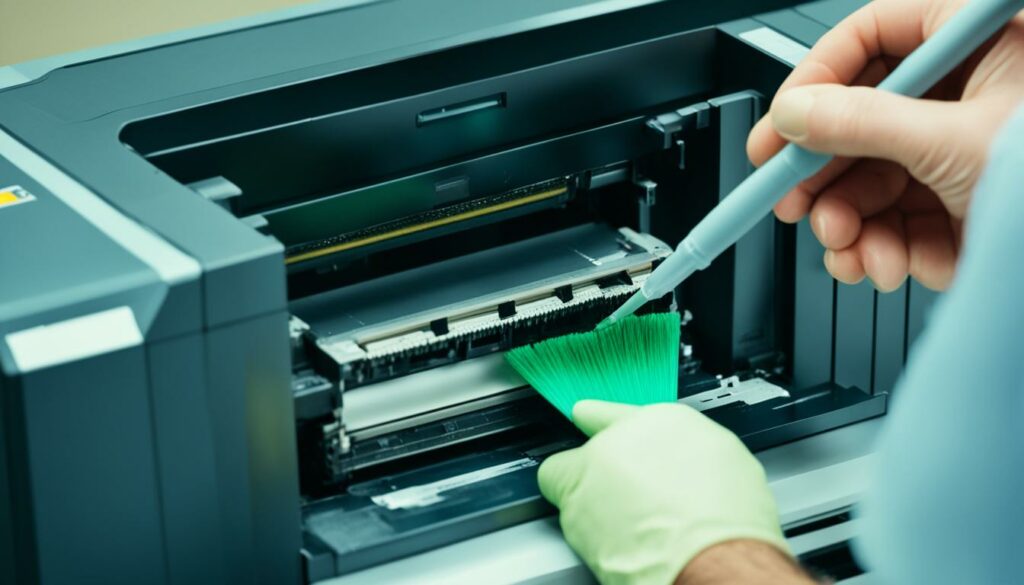
Recurrent print quality issues can be frustrating, but don’t worry, there are troubleshooting steps you can take to get your printer back on track. One possible reason for ongoing issues is that the cleaning process may not have fully resolved the problem. Try cleaning the printhead and ink cartridges again to ensure all clogs and dirt are removed.
Another simple yet effective troubleshooting step is to leave the printer unplugged overnight. This allows the internal components to reset and can often resolve minor issues that may be affecting print quality. Additionally, make sure to check the nozzle on the ink cartridges to ensure they are not clogged or damaged.
If the printer problems persist even after multiple cleaning attempts and overnight unplugging, it’s likely that the ink cartridges themselves may need to be replaced. Faulty cartridges can lead to print quality issues, so consider purchasing new cartridges from a reputable source.
If none of these troubleshooting steps solve the problem, it may be time to seek professional printer repair. Professional technicians have the expertise and specialized tools to diagnose and fix complex printer issues. They can identify the underlying cause of the print quality problems and provide the necessary repairs to get your printer back to its optimal condition.
Summary of Troubleshooting Steps:
- Clean the printhead and ink cartridges multiple times
- Leave the printer unplugged overnight
- Check the nozzle on the ink cartridges
- Replace ink cartridges if necessary
- Consider seeking professional printer repair
Remember, the goal is to ensure high print quality and efficient printer performance. Troubleshooting steps can help identify and address issues that may be affecting your printer’s functionality. By following these steps, you’ll be well on your way to resolving print quality problems and getting your printer back in top shape.
Call on an Expert from HP
If all else fails and you’re unable to resolve the print quality issues on your own, it’s advisable
to reach out to HP support or take your printer to a professional repair shop. HP experts can provide
guidance and assistance in troubleshooting and resolving any problems you may be facing with your printer.
They have the expertise and resources to diagnose and fix complex issues.
Why Choose HP Support?
When it comes to printer troubleshooting and professional repair, HP support stands out for several reasons:
- HP technicians are trained professionals who specialize in resolving printer issues.
- HP support provides personalized assistance tailored to your specific printer model and problem.
- Using HP support ensures you have access to genuine parts and equipment for repairs.
- HP support offers warranty coverage for eligible printers, saving you potential repair costs.
- HP has a vast network of service centers and authorized partners, making it convenient to find assistance near you.
Whether you’re dealing with print quality issues, error messages, or other printer problems, HP support
is dedicated to helping you get your printer back in working order.
“The experts at HP support can provide step-by-step guidance to troubleshoot your printer issues, saving you time and frustration.”
Professional Repair Shops
If you prefer a hands-on approach or if your printer is out of warranty, you can also consider taking
it to a professional repair shop. These shops often have experienced technicians who specialize in printer
repairs and can diagnose and fix a wide range of issues. Just make sure to choose a reputable repair shop
that uses high-quality parts and offers a warranty on their services.
Contacting HP Support
When reaching out to HP support, be prepared to provide them with relevant information, such as the printer
model, a description of the issue, and any error messages that appear. This will help them understand your
problem better and provide you with the appropriate solutions. You can contact HP support through their website,
by phone, or through their live chat service for immediate assistance.
Remember, when all else fails, HP support and professional repair shops are there to help you get your printer
up and running again, ensuring high-quality prints and smooth operation.
| Benefits of HP Support | Benefits of Professional Repair Shops |
|---|---|
| Expert guidance from trained professionals | Specialized technicians with experience in printer repairs |
| Personalized assistance tailored to your printer model and problem | Hands-on approach for resolving complex issues |
| Access to genuine parts and equipment for repairs | Wide range of repair services available |
| Warranty coverage for eligible printers | Opportunity for immediate repairs |
| Convenient network of service centers and partners | Assurance of high-quality repairs and parts |
Conclusion
Regularly cleaning the printhead is essential for maintaining optimal print quality and preventing potential breakdowns. Whether you choose to clean the printhead through software or manually, it’s important to follow the recommended steps and be cautious to avoid damaging the printhead or ink cartridges.
Remember to use genuine HP ink cartridges for best results. Using non-genuine cartridges may compromise print quality and cause damage to the printhead. Genuine HP ink cartridges are designed specifically for HP printers and ensure consistent performance.
If you’re still experiencing print quality issues, despite regular cleaning and using genuine HP ink cartridges, professional help may be necessary to diagnose and fix the problem. HP experts can provide the necessary expertise and resources to identify the root cause of the issue and provide effective solutions.
Source Links
- https://www.ldproducts.com/blog/how-to-clean-an-hp-printhead/
- https://www.hp.com/us-en/shop/tech-takes/how-to-clean-printhead
- https://www.hp.com/in-en/shop/tech-takes/post/how-to-clean-printhead

Morgan Azhari, the owner of PrinterUpdate.net, is a dedicated expert in the field of printers, leveraging a wealth of experience and education to create a platform that passionately shares insights and solutions.
With a goal to enhance the printer user experience, my vision for the website is to provide valuable content, making a positive impact on individuals navigating the complexities of printers.
